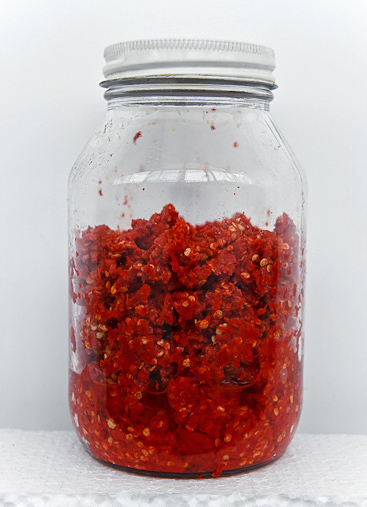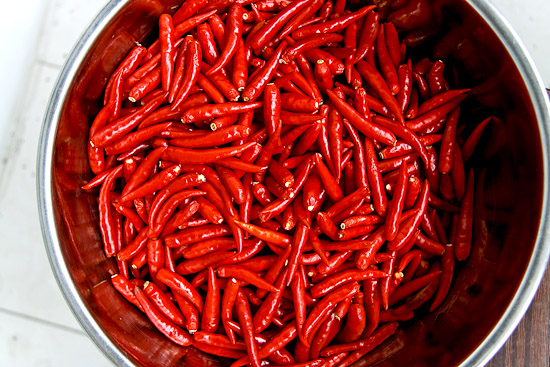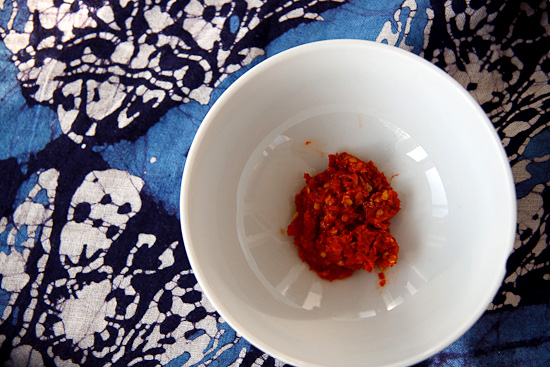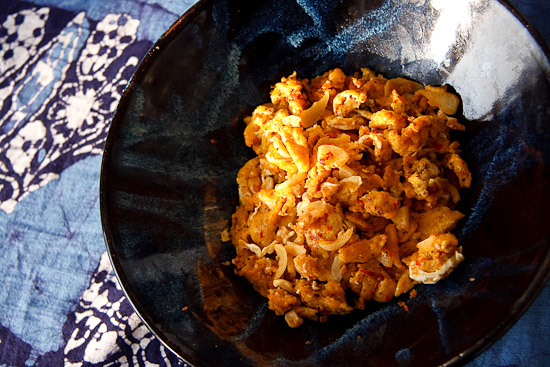Nothing says Guizhou to me like zao lajiao (糟辣椒), or fermented chili pepper paste. It exemplifies the best of Guizhou country cooking: homey, simple and bold in flavor. With a few slices of scallions and cloves of garlic, it can transform ordinary ingredients (cabbage! potatoes!) to a beautiful thing of complex spiciness.
Zao lajiao has a distinctive flavor – not only spicy and garlicky, but also with a sweet boozy bite from the bai jiu (high-alcohol Chinese grain liquor) that helps its fermentation. The character 糟 zao means to ferment in rice wine; it can also refer to the dregs of the rice wine, or alternatively, something gone wrong, as in 糟糕 (zaogao) – literally, cake gone bad.
You won’t find zao lajiao in upscale Guizhou restaurants. In Beijing, I go to Junqin Hua (君琴花), near the Art Museum, to satisfy my zao lajiao cravings. You can get almost any vegetable here made with their pepper paste: their zaola bamboo (竹笋 zhusun) is one of my favorite things to eat, ever, while zaola sticky rice cakes (饵块粑) and eggs (鸡蛋 jidan) are also astoundingly good. The zaola potato (土豆 tuduo) is sliced thinly and fried to a golden crisp – arguably better than most potato chips (crisps) sold in China. It really is the touch of magic.
In honor of the Beijinger‘s upcoming Hot Chili Pepper Eating Competition, here’s a recipe for zao lajiao. It’s surprisingly easy – as long as you don’t mind pulling the stems off hundreds of peppers (you could also do it in smaller batches, but it’s more efficient to do one large batch).
After it’s finished, the zao lajiao needs to ferment in a dark and cool place for two weeks until it’s ready to eat. You can add a spoonful – sized to your taste buds – along with the simple combination of scallions and garlic, to flavor any stir-fry. Bite the food, it bites back. This is a kind of equality.
Guizhou Fermented Chili Pepper Paste (Zao lajiao)
1,000g red chili peppers (2 lb and 3 ounces)
100g ginger (a medium-sized root, or about ¾ cup chopped)
50g garlic cloves (about one large head)
50g Chinese baijiu – hard grain liquor (4 tbsp)
100g salt (1/3 cup, or 5 tbsp and 1 tsp)
** Be sure that all of the equipment and utensils you use for are washed very well, with no trace of oil. I like to pour boiling hot water over everything, or steam them for 10 minutes. You’ll need several bowls for the ingredients, a blender or a food processor, and a large jar (with 750 ml /3 cups capacity). Make sure your hands are clean and dry.
Wash the chili peppers, ginger and garlic cloves. Be sure to let them dry thoroughly before working with them.
De-stem the chili peppers. Consider doing this while watching a movie, or a sporting event.
Grind the chili peppers, ginger and garlic in a blender or a food processor until everything is chopped into pea-sized bits. You may have to do this in several batches.
Stir in salt and half of the liquor, and mix well.
Place the chili pepper paste into the jar, which should already be cleaned and dried. You can use an earthenware vat if you want to be authentic. Pour the rest of the liquor over it.
Seal and place in a dark cool place. The chili pepper paste will be ready for consumption in 2 weeks, after which it should be kept in the refrigerator.
 Notes:
Notes:
When de-stemming the peppers, some protective gloves are recommended to protect your hands from the burning chili juices. If you want to mash up the peppers by hand, some protective eye gear would be good too.
The zao lajiao should be made with red chili peppers – ideally, something medium hot like the heaven-facing pepper (朝天椒 chaotian jiao), which is widely grown in southern China. You could also substitute a less spicy variety of pepper like cayenne – or, if you dare and can get ahold of them, go for the bhut jolokia.
The rice liquor doesn’t have to be fancy – I used some cheap erguotou. After all, it’s not the baijiu that will be setting your mouth on fire.







































Thanks for this! I love guizhou spiciness and this recipe makes it just a bit easier to attempt the dishes at home
Looks delicious! Can I substitute another alcohol (Whisky or bourbon)?
Yes, I think you could, but the flavor would be different! But it might be very interesting to see what it’d be like with whiskey. Probably best to choose an alcohol’ whose flavor you enjoy?